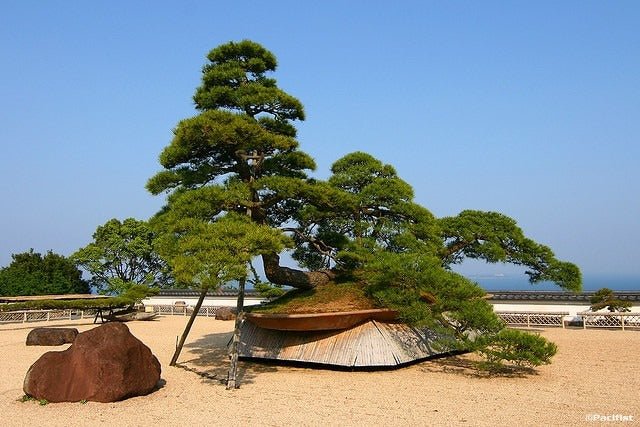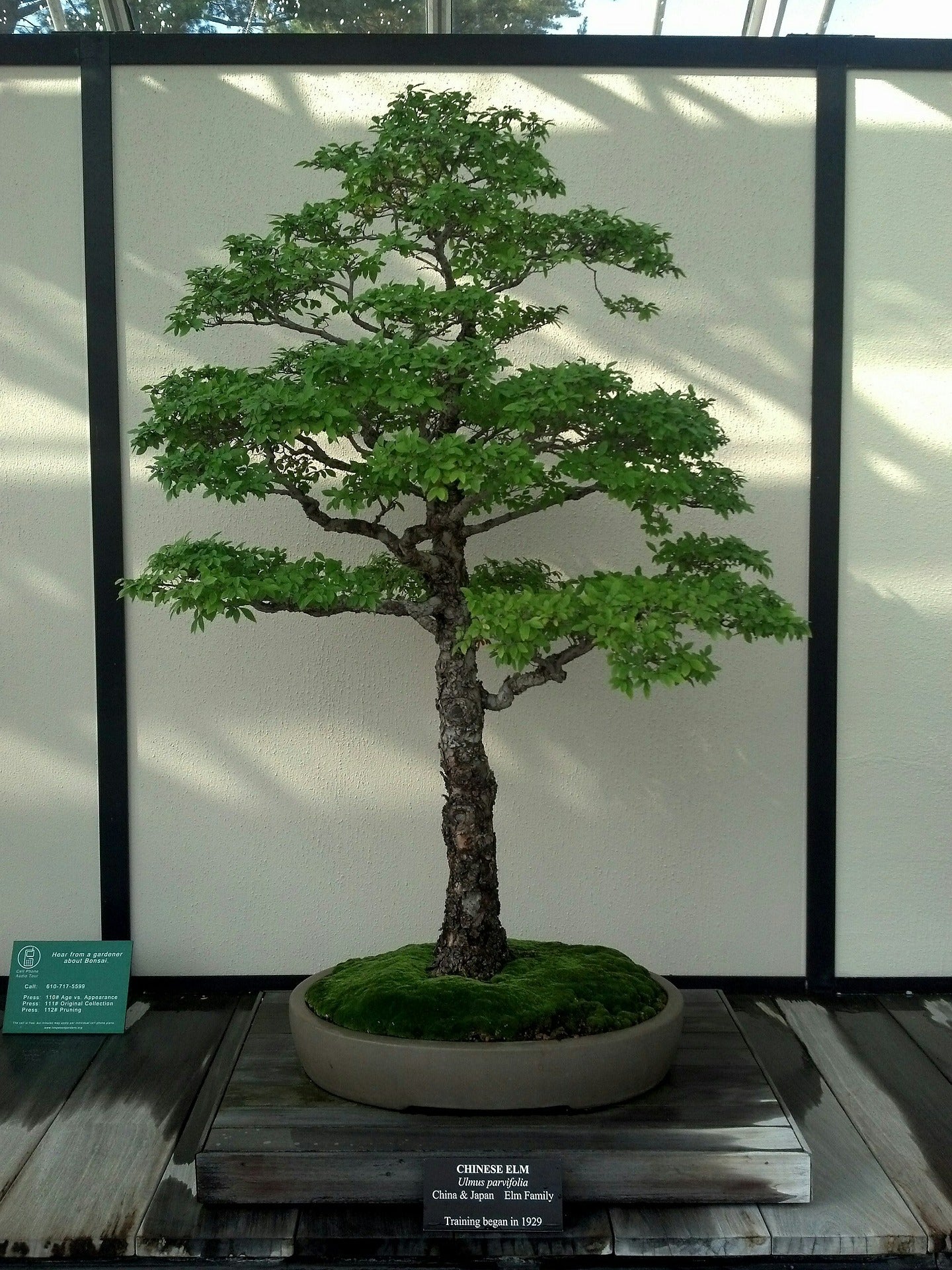Bonsai trees can grow large, but they are trained to stay small. Proper pruning and care keep them miniature.
Bonsai trees are miniature versions of full-sized trees, meticulously cultivated for aesthetic appeal. Originating from ancient Chinese and Japanese horticultural practices, bonsai trees require careful pruning and root trimming. This process ensures they remain small despite their potential to grow large.
Bonsai cultivation combines art and gardening, demanding patience and precision. These miniature trees symbolize harmony, balance, and simplicity. Enthusiasts often find the practice meditative and rewarding. With proper care, bonsai trees can thrive for many years, becoming cherished heirlooms. Understanding the basics of bonsai care is essential for maintaining their beauty and health.

Credit: www.farmanddairy.com
Bonsai Tree Basics
The art of growing bonsai trees is ancient. It requires patience, care, and dedication. Bonsai trees are small, but they can grow big with proper techniques. Understanding the basics is crucial to mastering this art.
Origins And History
The history of bonsai dates back over a thousand years. It began in China and then spread to Japan. The word “bonsai” means “planted in a container.” Ancient Chinese monks first practiced bonsai. They used it to bring nature inside their temples. Japanese culture later adopted and refined the practice. Today, bonsai is a global phenomenon, loved by many.
Fundamental Characteristics
Bonsai trees are miniature versions of full-sized trees. They are not special dwarf species. Instead, they achieve their size through pruning and training. Key characteristics include:
- Miniature Size: Bonsai trees are small but look like full-sized trees.
- Aesthetic Form: They are shaped to mimic natural tree forms.
- Container Growth: Bonsai trees grow in pots or containers.
- Pruning Techniques: Regular pruning keeps them small and healthy.
Understanding these basics helps in growing a healthy bonsai tree. They can grow big with the right care and techniques. Each bonsai tree is unique. Its growth depends on various factors, including species, climate, and care.

Credit: www.bonsaify.com
Growth Potential
Bonsai trees are fascinating and unique. They are miniature versions of full-sized trees. Many people wonder about their growth potential. Can a bonsai tree grow big? Let’s explore this topic.
Natural Limits
Bonsai trees have natural limits to their size. Their growth is controlled by pruning and root trimming. These techniques keep the bonsai tree small. Even with ideal care, they won’t grow to the size of normal trees.
Factors Influencing Size
Several factors affect the size of a bonsai tree:
- Species: Some tree species naturally stay small.
- Pruning: Regular pruning keeps the tree compact.
- Pot Size: Smaller pots restrict root growth.
- Root Trimming: Cutting roots limits tree size.
- Soil Quality: Good soil supports healthy growth.
- Watering: Proper watering is crucial for growth.
| Factor | Impact on Size |
|---|---|
| Species | Natural limit to size |
| Pruning | Prevents excessive growth |
| Pot Size | Limits root expansion |
| Root Trimming | Controls overall growth |
| Soil Quality | Supports healthy development |
| Watering | Affects growth rate |
Understanding these factors helps in maintaining a bonsai tree. It ensures they stay small and healthy. Remember, bonsai trees are meant to be tiny and beautiful. Their unique charm lies in their miniature form.
Common Misconceptions
Many people believe that bonsai trees can grow very large. This is one of the most common misconceptions about bonsai. Understanding the truth about bonsai tree growth can help enthusiasts care for their plants better.
Myths About Size
There are several myths about the size of bonsai trees:
- Bonsai trees will grow as big as regular trees.
- They need to be kept in small pots to stay small.
- All bonsai trees are naturally small.
These myths can lead to improper care. Bonsai trees are not a separate species. They are regular trees trained to remain small. Proper pruning and potting are crucial.
Clarifying Bonsai Growth
Let’s clarify some key points about bonsai growth:
- Pruning: Regular pruning keeps bonsai trees small. It involves trimming branches and roots.
- Pot Size: Bonsai trees are grown in small pots. This restricts their growth but does not harm them.
- Species: Any tree species can become a bonsai. The method, not the species, creates the bonsai.
A bonsai tree’s size depends on care techniques. Proper pruning, potting, and feeding are essential. Without these, a bonsai tree can outgrow its container.
| Myth | Fact |
|---|---|
| Bonsai trees grow as big as regular trees. | Bonsai trees stay small with proper care. |
| Small pots keep bonsai trees small. | Pruning and pot size control growth. |
| All bonsai trees are naturally small. | Any tree species can be a bonsai. |
Understanding these facts can help you grow a healthy bonsai tree. Remember, bonsai is an art form. It requires dedication and patience.
Cultivation Techniques
Bonsai trees are miniature versions of full-sized trees. They require special cultivation techniques to thrive. These techniques ensure the tree remains small and healthy.
Pruning Methods
Pruning is essential for shaping the bonsai tree. It helps control the size and shape. There are two main types of pruning: structural pruning and maintenance pruning.
- Structural Pruning: This involves cutting larger branches. It shapes the tree’s overall form.
- Maintenance Pruning: This involves trimming smaller branches. It maintains the tree’s shape and health.
Pruning should be done with sharp, clean tools. This prevents damage and disease.
Potting Practices
The right pot is crucial for bonsai trees. It affects the tree’s growth and health. Choose a pot that matches the tree’s size and style.
| Pot Size | Tree Type |
|---|---|
| Small Pot | Young Trees |
| Medium Pot | Growing Trees |
| Large Pot | Mature Trees |
Ensure the pot has good drainage. Poor drainage can cause root rot.
Repotting is also important. It should be done every 2-3 years. This prevents the roots from becoming crowded.
- Remove the tree from its pot.
- Trim the roots gently.
- Place the tree in a new pot with fresh soil.
These practices help your bonsai tree stay healthy and beautiful.
Ideal Conditions
Understanding the ideal conditions for growing a bonsai tree is crucial. These conditions ensure your bonsai remains healthy and beautiful. Let’s explore the key factors that contribute to the growth of a bonsai tree.
Climate Requirements
Bonsai trees thrive in specific climates. The ideal temperature range is between 60°F and 75°F. They need plenty of sunlight but avoid direct, harsh rays. Indoor bonsai trees prefer indirect light. Outdoor bonsai trees can withstand more direct sunlight. Humidity levels should be moderate. Avoid placing your bonsai near heating vents or air conditioners.
Soil And Water Needs
Soil is a critical factor for bonsai growth. The soil should be well-draining and nutrient-rich. A typical bonsai soil mix includes akadama, pumice, and lava rock. These components ensure proper aeration and moisture retention. Avoid using regular garden soil.
Watering your bonsai tree correctly is vital. Over-watering can lead to root rot, while under-watering can dry out the tree. Water your bonsai when the topsoil feels dry. Ensure the water drains well to avoid waterlogging. A humidity tray can help maintain optimal moisture levels.
| Condition | Requirement |
|---|---|
| Temperature | 60°F – 75°F |
| Light | Indirect sunlight (indoor), Direct sunlight (outdoor) |
| Humidity | Moderate levels |
| Soil | Well-draining, nutrient-rich |
| Watering | Water when topsoil is dry, avoid waterlogging |
Popular Bonsai Species
Bonsai trees are a fascinating art form that many people love. There are various species that are popular in the bonsai world. These species range from tiny, delicate plants to larger, more robust trees. Let’s explore some of the most popular bonsai species that enthusiasts cultivate.
Small Varieties
Small bonsai trees are perfect for indoor spaces and beginners. These trees require less space and are easier to manage.
- Ficus: Known for their hardiness and easy care. These are great for beginners.
- Jade: These succulent plants are popular for their unique appearance and easy maintenance.
- Chinese Elm: This species is perfect for creating intricate branch structures.
Larger Species
Some bonsai species can grow larger, making them more suitable for outdoor spaces. These trees can be more challenging but rewarding to grow.
- Japanese Maple: Known for their beautiful leaves that change color with the seasons.
- Pine: These trees are iconic in bonsai art, known for their rugged appearance.
- Juniper: Popular for their flexibility and ability to create dramatic shapes.
| Bonsai Species | Size | Care Level |
|---|---|---|
| Ficus | Small | Easy |
| Jade | Small | Easy |
| Chinese Elm | Small | Medium |
| Japanese Maple | Large | Medium |
| Pine | Large | Hard |
| Juniper | Large | Medium |
Choosing the right species is crucial for bonsai success. Small varieties are great for beginners, while larger species offer more challenges and rewards. Understanding the needs of each species helps in growing a healthy bonsai tree.
Challenges In Growth
Growing a bonsai tree presents unique challenges. Despite their miniature size, bonsai trees require meticulous care to thrive. Understanding these challenges helps in cultivating a healthy bonsai.
Common Problems
Many people face common problems while growing bonsai trees. Here are some of the most frequent issues:
- Root Rot: Overwatering can cause the roots to decay.
- Pests: Insects like aphids and spider mites can infest the tree.
- Leaf Drop: Stress from improper care can cause leaves to fall.
- Stunted Growth: Lack of nutrients or poor soil can hinder growth.
Maintenance Tips
Proper maintenance is crucial for the healthy growth of bonsai trees. Follow these tips to ensure your bonsai thrives:
- Watering: Water the tree when the soil feels dry.
- Pruning: Trim branches and roots regularly to maintain shape.
- Fertilizing: Use bonsai-specific fertilizers to provide essential nutrients.
- Lighting: Place the tree in a spot with adequate sunlight.
| Problem | Solution |
|---|---|
| Root Rot | Allow soil to dry between waterings |
| Pests | Use insecticidal soap or neem oil |
| Leaf Drop | Ensure proper watering and lighting |
| Stunted Growth | Repot with nutrient-rich soil |
Realistic Expectations
Understanding the realistic expectations of growing a Bonsai tree is crucial. Many people wonder, “Can Bonsai trees grow big?” Let’s dive into what you can realistically expect.
Lifespan And Size
Bonsai trees can live for many years. Some even outlive their owners. The size of a Bonsai tree depends on its species and care. Typical Bonsai trees range from 6 inches to 3 feet tall. They rarely grow bigger because they are pruned and shaped.
| Bonsai Type | Typical Height |
|---|---|
| Mame Bonsai | Up to 6 inches |
| Shito Bonsai | Up to 4 inches |
| Chuhin Bonsai | Up to 18 inches |
| Omono Bonsai | Up to 3 feet |
Achieving Desired Results
To achieve the desired size, regular pruning is essential. Watering and sunlight are also crucial. Proper soil and nutrients help the tree stay healthy. Use a mix of Akadama, pumice, and lava rock. This ensures good drainage and root health.
- Pruning: Trim the branches and leaves regularly.
- Watering: Keep the soil moist but not soggy.
- Sunlight: Ensure the tree gets enough light.
- Soil: Use a well-draining soil mix.
Patience and dedication are key. Growing a Bonsai tree takes time. Enjoy the process and watch your tree flourish.

Credit: natureit.co
Conclusion
Bonsai trees can grow larger, but maintaining their small size is an art. Proper care, pruning, and techniques keep them miniature. Understanding their needs ensures they remain healthy. Bonsai gardening is a rewarding hobby that combines nature and creativity. Explore this fascinating world and enjoy your miniature trees.

